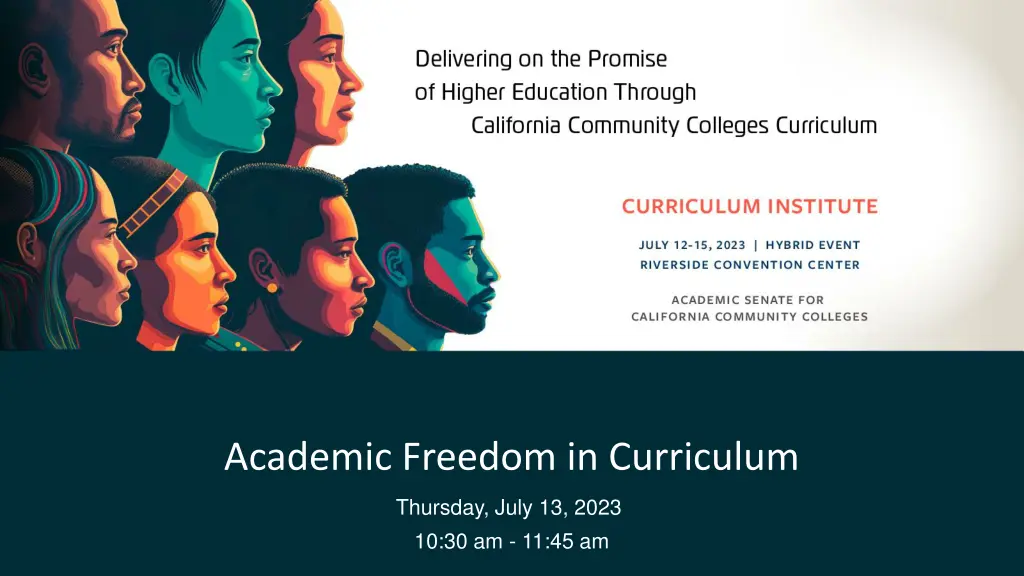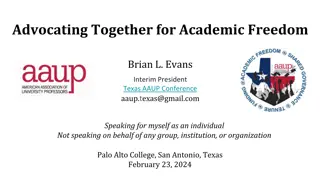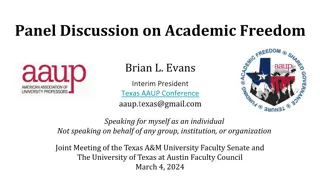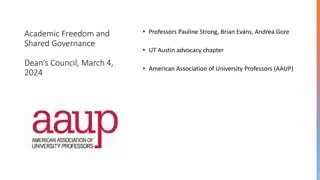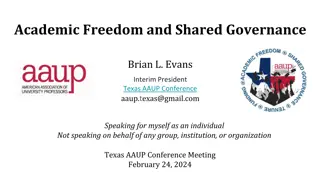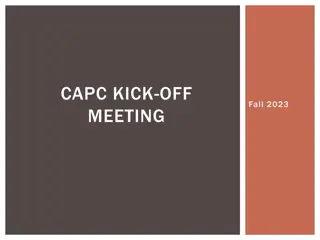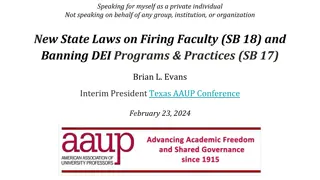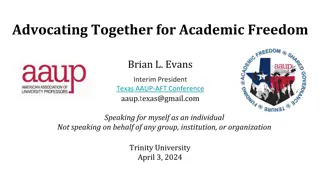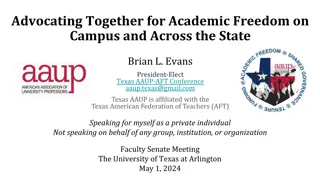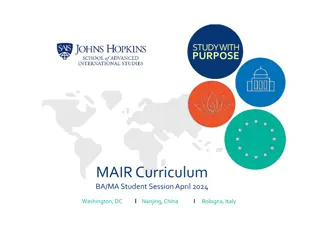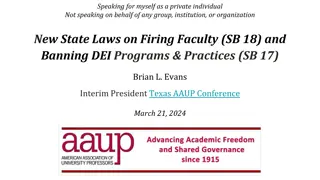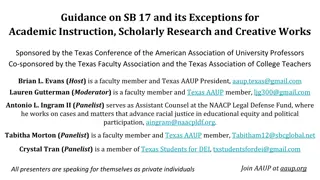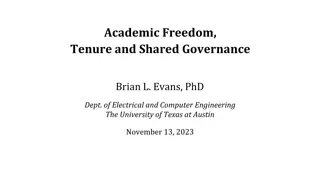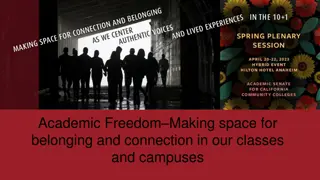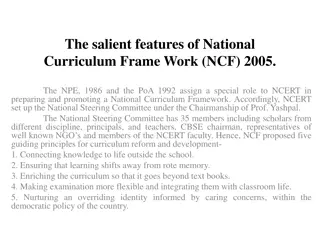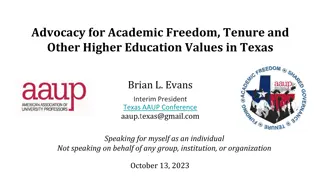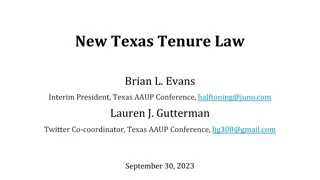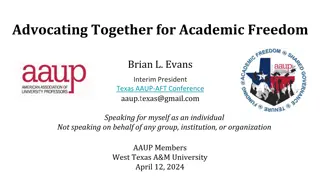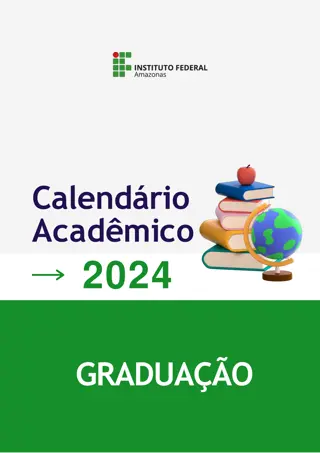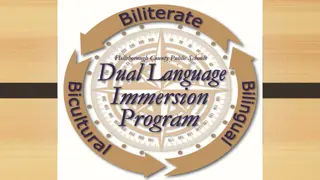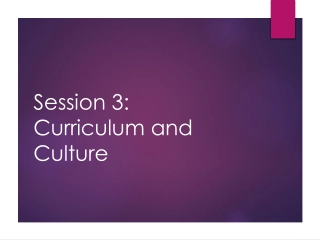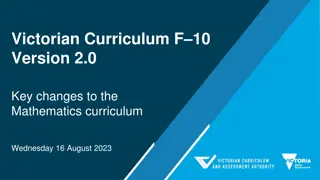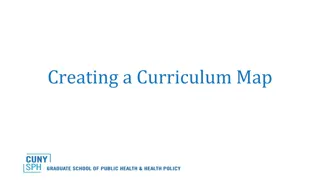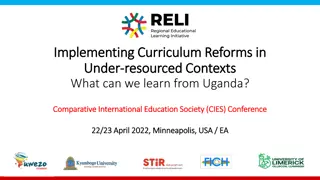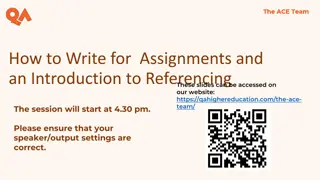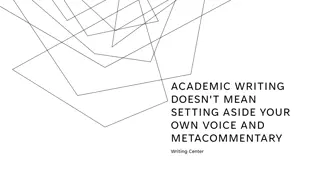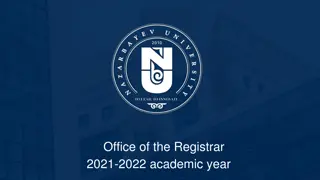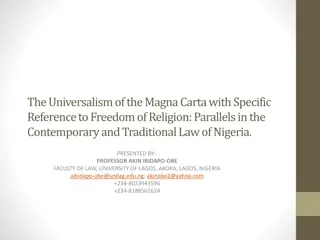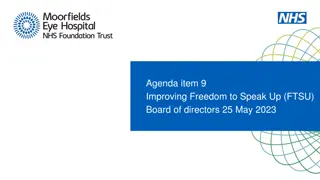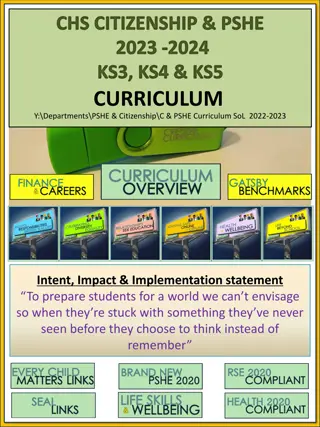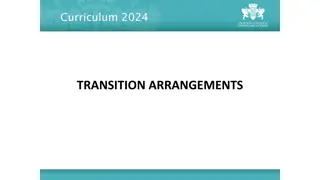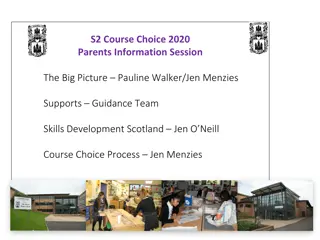Enhancing Academic Freedom in Curriculum
Explore academic freedom's role in creating inclusive learning environments by challenging traditional paradigms. Join discussions on curriculum's relationship to academic freedom and fostering student belonging in higher education spaces.
Download Presentation

Please find below an Image/Link to download the presentation.
The content on the website is provided AS IS for your information and personal use only. It may not be sold, licensed, or shared on other websites without obtaining consent from the author. Download presentation by click this link. If you encounter any issues during the download, it is possible that the publisher has removed the file from their server.
E N D
Presentation Transcript
Academic Freedom in Curriculum Thursday, July 13, 2023 10:30 am - 11:45 am
Presenters Juan Arzola, College of Sequoias, ASCCC At-Large Representative Erik Reese, Moorpark College, ASCCC Area C Representative Janet Williams, North Orange Continuing Education, DE Faculty Coordinator
Session Description Academic freedom is a fundamental concept to ensure that institutions of higher education function for the public good without undue pressure from external influences. Part of academic freedom provides faculty freedom in the classroom to discuss their subject. This provides an opportunity to introduce theories, concepts, and experiences that challenge long-held patriarchal and Eurocentric paradigms of higher education to create a more inclusive environment in our learning spaces. Join us for discussions about academic freedom, its relationship to curriculum, and how it provides the opportunity to create a sense of belonging for all our students, particularly those often marginalized and silenced within academia.
Outline Mission Academic Freedom Basics Faculty Perspective Academic Freedom Basics Student Perspective Academic Freedom and Curriculum IDEAA, Academic Freedom, and Curriculum
Mission Comprehensive Mission Statement Ed Code 66010.1-66010.7 Higher Education Missions Ed Code 66010.4 66010.2 (c): Educational equity not only through a diverse and representative student body and faculty but also through educational environments in which each person, regardless of race, gender, gender identity, gender expression, sexual orientation, age, disability, or economic circumstances, has a reasonable chance to fully develop his or her potential. Statement on Diversity, Equity, and Inclusion in the California Community Colleges Title 5 51201 Local College Mission Statements Everything we do ought to align with the mission Intentionality
Poll: Academic Freedom & the Faculty Perspective 1. 2. 3. Please get out your phone Open the camera app Be ready to answer a question honestly (and anonymously)
Poll 1 via Slido Is academic freedom in the classroom absolute? Start presenting to display the poll results on this slide.
Academic Freedom: What is it? Why is it important? Academic Freedom is required so that the faculty professionals who teach and research are protected from external forces that might try to influence the development of culture, science, and knowledge in order to serve any interest other than the intellectual, socioeconomic, and socioemotional advancement of students through the attainment of education.
AAUP 1940s Statement on Academic Freedom Academic Freedom procedures related to academic freedom should address the following best practices from the AAUP: Research and publication of the results Classroom in discussing their subject When they speak or write as citizens, they should be free from institutional censorship or discipline Academic freedom is not absolute or equivalent to freedom of speech
Things Academic Freedom Allows Academic freedom typically allows faculty to do the following: Present the course content (per the Course Outline of Record) in the way they deem most appropriate Determine the assignments, readings, assessments, and exams that will work best for their class. To create a classroom environment where controversial topics can be discussed without being censored as long as the topic relates to the course and with recognition of students right to first amendment (freedom of speech)
Academic Freedom & Freedom of Speech: 1 of 2 Freedom of Speech 1st amendment right for faculty AND students Restricts the right of a public institution, including a public college or university, to regulate expression Instructors are not to required to provide class time for students to voice views that contradict the material being taught however, instructors are required to allow students to express opposing views and values to some extent where the instructor invites expression of students personal opinions and ideas
Academic Freedom & Freedom of Speech: 2 of 2 Freedom of Speech In the classroom, speech must be germane to the subject matter and advances an academic message (stick to your subject) Private institutions first amendment protections are often limited and do not have the same protections as public institutions Email on a district server, electronic communications, and faculty pages are not necessarily protected under free speech
Academic Freedom Policy Required by Title 5 51023. Faculty. The governing board of a community college district shall: (a) adopt a policy statement on academic freedom which shall be made available to faculty; (b) adopt procedures which are consistent with the provisions of sections 53200-53206, regarding the role of academic senates and faculty councils; (c) substantially comply with district adopted policy and procedures adopted pursuant to subdivisions (a) and (b).
Academic Freedom Policy Required for Accreditation ACCJC s Standard I.C.7 formalizes this requirement In order to assure institutional and academic integrity, the institution uses and publishes governing board policies on academic freedom and responsibility. These policies make clear the institution s commitment to the free pursuit and dissemination of knowledge and its support for an atmosphere in which intellectual freedom exists for all constituencies, including faculty and students. 2024 Standard 4.1 The institution upholds an explicit commitment to principles of academic freedom, academic integrity, and freedom of inquiry.
Attacks on Academic Freedom On May 15, Florida Governor Ron DeSantis signed bill (S 266) banning public colleges and universities from spending money on diversity, equity, and inclusion programs Sustained effort to legislate educational curriculum Thirty-eight out of fifty states either have passed or have active proposed pieces of legislation that impact academic freedom; Focused primarily on an Anti-CRT (Critical Race Theory); and Opposes social justice, equity, and anti-racist curriculum that teaches students to hate everything that makes America great. (Greene, 2022)
Poll: Academic Freedom & The Student Perspective 1. 2. 3. Please get out your phone Open the camera app Be ready to answer a question honestly (and anonymously)
Poll 1 via 2lido What is your familiarity with district and college policies that have, or will have, a "significant effect on students" in Title 5 51023.7, commonly referred to as "9+1"? Start presenting to display the poll results on this slide.
Protections Based on Faculty Employment Status Tenured faculty, tenure track faculty, non-tenure track faculty Examples involving Academic Freedom Evaluations OER & ZTC
Protecting Student Academic Freedom: 1 of 2 Role of Student Senates Advocate for the students freedom to challenge ideas that may not fully align with the student s vision. Collaboration between Student Senates (SBAs), College Governance, and District Committees targeted on creating policies for student success. The Student Senate for California Community Colleges (SSCCC) works endlessly to create resolutions, policies, and advocacy tool packages in different areas to advocate for students basic rights statewide. Educators must be familiar with students basic rights, such as 9+1 rights, among others. It is important that students and faculty provide input on issues around their campuses on how those issues can be solved.
Protecting Student Academic Freedom: 2 of 2 (1) curriculum, including establishing prerequisites and placing courses within disciplines (2) degree and certificate requirements (3) grading policies (4) educational program development (5) standards or policies regarding student preparation and success (6) district and college governance structures, as related to faculty roles (7) faculty roles and involvement in accreditation processes, including self-study and annual reports (8) policies for faculty professional development activities (9) processes for program review (10) processes for institutional planning and budget development (11) other academic and professional matters as are mutually agreed upon between the governing board and the academic senate Faculty Academic and Professional Matters "10+1" Significant Effect on Students "9+1" (1) grading policies (2) codes of student conduct (3) academic disciplinary policies (4) curriculum development (5) courses or programs which should be initiated or discontinued (6) processes for institutional planning and budget development (7) standards and policies regarding student preparation and success (8) student services planning and development (9) student fees within the authority of the district to adopt (10) any other district or college policy, procedure, or related matter that the district governing board determines will have significant effect on students
Poll: Instructional Design 1. 2. 3. Please get out your phone Open the camera app Be ready to answer a question honestly (and anonymously)
Poll 3 via Slido Does instructional design primarily impact online courses? Start presenting to display the poll results on this slide.
Defining Instructional Design Instructional design is the practice of creating learning experiences to support learning. It is a systems approach to analyzing, designing, developing, implementing, and evaluating any instructional experience Based on the belief that training is most effective when it gives learners a clear statement of what they must be able to do after training and how their performance will be evaluated (What is Instructional Design?, n.d.).
Academic Freedom & Instructional Design With freedom comes responsibility (Hawkins, 2023; Scutelnicu et al., 2019) Regardless of how academic freedom is interpreted, faculty members have an ethical obligation to deliver instruction in ways that do not violate students' rights to learn. Consequently, institutions have a right as well as a duty to compel their faculty members to follow through with this obligation (Poore-Pariseau, 2009).
Subject Matter Expert (SME) & Instructional Designer (ID) Collaboration Ideally, the subject matter expert and instructional designer are a team! Carliner s lit review (2021), identified seven factors that facilitate that relationship. 1. Communication: sharing a common vocabulary 2. Attitude: being mentally prepared to work as a team 3. Trust: developing a rapport and getting buy-in 4. Commitment: completing assigned tasks on time and sharing responsibilities for the quality of courses 5. Flexibility: allocating enough time to work yet being willing to adjust 6. Empowerment: level of control over the course-design process and level of autonomy during the design 7. Healthy workplace culture: adequate resources, transparent design process, ensuring every member s work is valued.
Factors Hindering SME & ID Collaboration 1. Lack of clarity on the role of the ID 2. Ineffective communication 3. Heavy workload 4. Concern for academic autonomy 5. Ambiguity of status Lack of institutional support for an ID.
What About Canvas? Templates may be viewed as an infringement on academic freedom by some faculty members because it appears too prescriptive at first glance However, a 2012 survey conducted at the University of Baltimore noted that the quality of online learning and student satisfaction were dependent upon instructional design (Gillingham & Molinari, 2012)
Canvas Templates & Academic Freedom Another study conducted at a department of public administration program at a mid-Atlantic university found that a collaborative effort with faculty resulted in a high satisfaction rate when implementing templates for online courses Approximately 78% of them strongly and somewhat agreed that the template was helpful in terms of entry point consistency, standardization, layout, and ease to locate foundation information. Of faculty respondents, 67% strongly and somewhat agreed that the template was helpful in terms of ease to identify materials and being clear; and 56% of them considered the template provided ease in identifying faculty information (Scutelnicu et al., 2019).
Impact on Faculty Workload Using the template to create a course 47 faculty hours Switching to the template halfway through the alignment process 55 faculty hours 60 instructional designer support hours Switching to the template to remediate the course for final alignment 170 faculty hours 70 instructional designer hours
Academic Freedom & the COR Instructors must teach to the COR (Course Outline of Record) Use of Academic Freedom to develop COR Embed equity in the COR Resolution 9.01 Fall 2021: Adding Culturally Responsive Curriculum, Equity Mindedness and Anti-Racism to Course Outline of Record (COR) Requirements in Title 5 CCCO Guidance DEI in Curriculum: Model Principles and Practices
IDEAA, Academic Freedom, & Curriculum: 1 of 2 The connection between academic freedom and equity is fundamental. Without the rights of faculty to speak, research, and pursue diverse ideas, equity is not possible. Academic freedoms allow faculty to academically challenge racist ideologies and structures in the context of their expertise
IDEAA, Academic Freedom, & Curriculum: 2 of 2 Academic freedom allows students to be introduced to a diverse range of ideas that often contrast and compete with each other within an academic framework and invites them to participate in rigorous analysis, the development of an independent critical judgment Allows faculty members the freedom to shape their courses in a way that allows for their subjects to be viewed, analyzed from different and specific lenses, particularly when the contrast with more traditional established theories
Next Steps: Role of Academic Senates & Curriculum Committees Review and revise college governance policies to ensure that academic freedom is protected for all faculty Provide professional development on the privileges and responsibilities of academic freedom for all faculty, administrators, and board members Adopt a statement regarding the parameters and practice of academic freedom in a variety of areas such as: evaluations the implementation of diverse and innovative pedagogies curriculum grading policies
Union Collaboration Academic Freedom is an area of overlapping purview between the Senate and the Union In support of academic senates and unions working together, the 2005 AAUP statement goes on to say that [s]trong senates and strong union chapters can work together to preserve and protect academic freedom on campus. Together, they establish the institutional terrain and precedents on which individual rights are defined, defended, and sometimes adjudicated. Recommend the Senate and Union have a joint understanding
Be Prepared Collaborate with all stakeholders to proactively develop policies and processes to support academic freedom and IDEAA for faculty and students. Possible resources to facilitate challenging conversations: ASCCC Adopted position: Local academic senates should work with union colleagues to develop due process around violations or perceived violations that involve academic freedom issues, including a duly constituted appointed or elected faculty committee to review and recommend action. Possible models for making recommendations to the college president Academic Senate Academic Freedom committee Union Academic Freedom committee Joint Academic Senate and Union Academic Freedom committee
Final Thoughts: Whats Next? 1. 2. 3. Please get out your phone Open the camera app Be ready to answer a question honestly (and anonymously)
Poll 4 via Slido What next steps have you identified for your campus? Start presenting to display the poll results on this slide.
Questions? Do you have additional questions that were not addressed?
Resources Questions info@asccc.org deco@cccdeco.org Protecting the Future of Academic Freedom During a Time of Significant Change 2020 position paper Academic Freedom and Equity 2020 Rostrum article CCCDECO California Community College Distance Education Coordinators' Organizations
References Bowen, R. S. (2010, June 10). Understanding by Design. Vanderbilt University. https://cft.vanderbilt.edu/guides-sub-pages/understanding-by-design/ Carliner, Y. C. S. (2021). A Special SME: An Integrative Literature Review of the Relationship between Instructional Designers and. Performance Improvement Quarterly, 33(4), 471 495. Hawkins, S. (2023, February 28). Sometimes Diversity Trumps Academic Freedom. The Chronicle of Higher Education. https://www.chronicle.com/article/sometimes-diversity-trumps-academic- freedom?utm_source=Iterable&utm_medium=email&utm_campaign=campaign_6400347_nl_Academe- Today_date_20230316&cid=at&source=&sourceid= Poore-Pariseau, C. (2009). Should Faculty Members be Exempt From a Mandate to Receive Instructional Design Training Because of Their Rights Under Academic Freedom? Journal of Academic Ethics, 7(3), 223 230. Scutelnicu, G., Tekula, R., Gordon, B., & Knepper, H. J. (2019). Consistency is key in online learning: Evaluating student and instructor perceptions of a collaborative online-course template. Teaching Public Administration, 37(3), 274 292.
